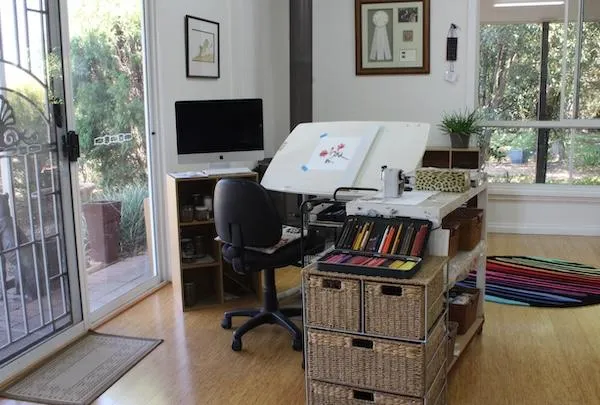
Creating the Ideal Studio Set-Up for Pencil Artists
Creating the Ideal Studio Set-Up for Pencil Artists
When we think about developing our skills as pencil artists, we often focus on techniques, materials, and practice. But one of the most overlooked aspects of growth is the environment in which we create. A well-planned studio set-up, whether it’s a dedicated room or a simple table and chair, can make a profound difference to both your productivity and your enjoyment of drawing.
Your studio should be more than just a workspace. It should be a space that feels personal, comfortable, and inspiring. With the proper set-up and a disciplined practice, you can transform your creative time into something both enjoyable and sustainable.
The Comfortable Workstation
Hours spent at the drawing table require care for both your body and your art. A supportive chair and workstation at the correct height are essential. A computer chair on castors can be a good choice, allowing you to roll back regularly to review your work. Many artists prefer a drawing board on castors for flexibility and ease of use.
Working on an angled easel helps reduce strain on the neck and back and provides a clearer perspective on your drawing. Here is an example of a desk easel that has adjustable angles for comfort.
A simple hand-bridge, which can be made from a piece of timber with felt pads, can save your work from smudging and keep your hand relaxed. See my video here:
Keep your art tools within easy reach. Whether you prefer tins, cups, or drawers, organisation is personal. What matters most is having your pencils and sharpeners ready so you can stay focused.
Don’t forget your body. Stretch every twenty minutes, roll your shoulders, shake your arms, and stay aware of how you’re sitting. Temperature is another overlooked factor; if you’re too hot or too cold, you’ll find it challenging to remain at your desk.
2. Lighting for Accuracy
Good lighting is one of the most important investments you can make. Natural light is ideal, with northern light in the Northern Hemisphere and southern light in the Southern Hemisphere providing the most consistent illumination.
Supplementary lighting is essential for long or late sessions. A duo daylight lamp with adjustable arms and brightness levels can make an enormous difference to your accuracy. Always check the direction of your light source. If you are right-handed, it’s best to have the light on your left to avoid casting shadows over your work.
This duo daylight clamp light is highly recommended. Each flexible arm has four brightness settings and clamps easily to a table or easel.
3. Creating a Personal and Positive Ambience
A clean, decluttered studio creates space for clarity and focus. But don’t be afraid to make it personal. Add a pot plant, a framed photograph, or a favourite quote; these small touches help transform a functional space into a creative sanctuary. Really go to town here and see how special you can make it so that you love to sit down surrounded by your favourite little bits and pieces that inspire you to stay there and draw.
Consider what helps you feel at ease regarding the surrounding sounds. Some artists prefer silence, while others thrive with background music or the sound of nature. Find the ambience that helps you concentrate and stay connected with your artwork.
4. Storage Solutions
Efficient storage supports both organisation and creativity. Small drawers are excellent for storing pencils, sharpeners, and paper, while map drawers are ideal for large sheets of paper. Trays can also help to keep your working pencils tidy and visible.
The less time you spend searching for materials, the more time you can dedicate to drawing.
5. Discipline in Studio Practice
Even the best studio set-up will not help if you don’t establish disciplined practices within it. Consistency is key. Set clear studio hours and respect them as professional time, even if you’re working from home. Let family and friends know that your creative time matters.
Balance periods of focus with short breaks to avoid fatigue. At the end of each session, take a moment to reflect on what worked well and what needs further attention. This habit of review not only sharpens your skills but also helps you progress steadily from one drawing to the next.
Final Studio Thoughts
Your studio should be a place where you look forward to spending time, a space that supports your body, mind, and creativity. By combining comfort, good lighting, organisation, and discipline, you create an environment that nurtures your growth as a pencil artist.
A studio is never just a room. It’s the foundation of your creative practice and the quiet engine that drives your artistic journey.
